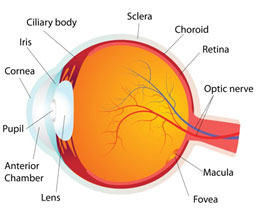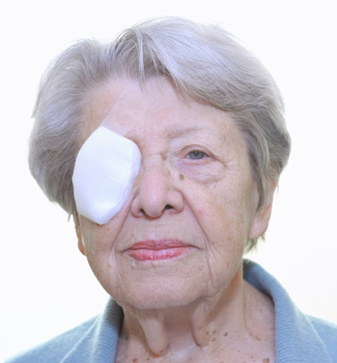
Cataract
What is a Cataract?
A cataract occurs when there is a progressive clouding of the natural crystalline lens in the eye, causing decreased vision. Over an extended period of time, if left undetected or untreated, it can lead to blindness.
What is the lens of the eye?
The crystalline lens, like the lens in a camera, is the part in the eye which helps focus light rays onto the retina. The retina is a structure in the back of the eye which is light-sensitive, like the film in a camera. The retina is where the eye converts the light rays to nerve signals which are then sent to the brain to form an image for our eyes to see.
The lens needs to be clear for the brain to receive an image. If the lens loses its transparency, it will make a blurred image.

What are the different types of Cataracts?
Age-related Cataract
As we age, protein builds up in the lens and continues to grow layers upon layers on its surface. Over time, all these layers clump together and become cloudy in some areas of the lens. The cloudier the lens becomes, the blurrier the vision a person may notice.Congenital Cataract
Cataract can sometimes be present at birth as a result of infection during pregnancy, injury or delayed development or birth defect. Cataract can also be developed during the early stages of childhood. Congenital cataracts may be so small that no treatment is required. If it does affect the vision, then immediate removal of the cataract is required.Traumatic Cataract
Cataract can occur following a direct penetration or blunt trauma to the lens. This can be from an injury such as a motor vehicle or sporting accident. Other causes include infra-red radiation and electric shocks. The cataract can develop immediately or years later.Secondary Cataract
These cataracts are often a result of other medical conditions such diabetes or glaucoma. Excessive use of steroids and exposure to radiation and UV light is also linked to cataract development.
Who is at risk of developing a Cataract?
The risk of developing a cataract increases as you grow older. Other risk factors include:
- Prolonged behaviours such as smoking and alcohol intake.
- Family history of cataract
- Diabetes
- Glaucoma
- Long term UV light exposure
- Obesity
- Prolonged use of and high doses of steroid medications.
What are the symptoms of having a Cataract?
The main symptom people report is blurry or cloudy vision. This is due to the cataract scattering the light entering the eye.
Other common symptoms include:
- Colours appear washed out or faded
- Glare – headlights, street lights or sunlight may appear too bright and halos may appear around lights.
- Poor night vision – less able to read and drive at night
- Double or multiple vision
- Frequent need for spectacle prescription change.

How to prevent a Cataract from developing?
Cataract is a progressive eye condition which can eventually cause blindness if not detected or treated. There are many ways you can help prevent cataract development or slow its progression. These include:
- Quit smoking
- Reduce alcohol consumption
- Wear sunglasses and hat when outdoors on a sunny day
- Manage health problems such a keeping your blood sugar levels in check if you are Diabetic.
- Maintain a healthy lifestyle – eat plenty of fruit and vegetables and exercise regularly
- Have a regular eye examination – if you are age 50 or older, it is highly recommended that you visit an Ophthalmologist once every 2 years for an eye assessment.
How is a Cataract detected?
Cataract is detected through an eye examination by the Orthoptist and Ophthalmologist. During the examination a few tests will be performed, including:
Visual acuity test
This eye test will measure how well each of your eyes can see at a far distance and close up distance.
Slit-lamp exam
Your Ophthalmologist will closely examine your eyes through a special microscope. He or she will be able to see in detail your cornea, iris and lens, and will be able to pick up any abnormalities present. It is here that any signs of a cataract will be detected.
Retinal exam
Drops will be put in your eyes to widen (dilate) your pupils so the doctor can have a good view of the back of the eye. Your doctor will also look for signs of any other underlying eye conditions such as glaucoma and macular degeneration.

Cataract Surgery
Symptoms of an early cataract can be improved with updated glasses or contact lenses, adjusting the lighting when reading and wearing sunglasses when going outside. These approaches usually don’t last very long so when the cataract matures and interferes with your daily lifestyle; surgery is the only effective treatment. Cataract surgery involves removing the cloudy natural lens and replacing it with a clear artificial intra-ocular lens (IOL). Surgery is performed as an outpatient, day only procedure which means there is no requirement to stay overnight.
Pre-operative tests for Cataract surgery
Before surgery, various measurements will be taken of your eye to help the Ophthalmologist choose the correct intra-ocular lens to implant in your eye. These measurements include your refractions, the length or your eye, and the curvature of your cornea.
Types of Intra-ocular Lens (IOLs)
We provide a range of refractive IOLs such as spherical, toric and multifocal IOLs which are tailored to your individual needs. Your ophthalmologist will discuss with you which is the most suitable IOL for you.
Cataract Surgery Procedure
Prior to the procedure, the anaesthetist will put local anaesthetic in your operating eye and sedation to help you feel calm during the procedure.
Phacoemulsification
This is most common method of removing a cataract. The Ophthalmologist makes a small incision on the cornea and inserts a tiny probe that transmits high frequency ultrasound waves to break up the lens and remove by suction. An IOL is then carefully inserted in the eye. The incision site is so small that no stitches are required.
Laser-assisted Cataract Extraction
At South West Vision Institute, we offer the latest cataract surgery technique – laser-assisted cataract removal. A computer-guided Femtosecond laser is used to make the incision on the cornea and break up the cataract. Advantages of laser assisted cataract surgery include:
- Bladeless
- Gentler procedure
- More precise incisions

After Cataract Surgery
After the surgery, you will go home with a patch over the operated eye and eye drops to use for the next month. It is very important that you use the eye drops as prescribed by the Ophthalmologist to promote healing, attend post-operative appointments and follow post-operative instructions.
Risks and complications of Cataract Surgery
As with any type of surgery, there are risks associated with cataract surgery such as:
- Bleeding in the eye
- Infection
- Glaucoma
- Retinal detachment
- Swelling of the cornea or retina
- Loss of vision
- Ruptured lens
Fortunately, the likelihood of developing cataract surgery complications is low. Your ophthalmologist will discuss with you the risks of surgery. The large majority of people undergoing cataract surgery achieve excellent results.
